The Microsoft Surface Laptop 2 Review: Surface Essentials
by Brett Howse on March 28, 2019 8:00 AM EST- Posted in
- Laptops
- Microsoft
- Surface
- Surface Laptop
- KBL-R
- Surface Laptop 2
System Performance
Due to Microsoft’s longer support windows, the original Surface Laptop’s dual-core Kaby Lake-U series processors were quickly surpassed when Intel updated to Kaby Lake Refresh, which offers twice the cores and twice the threads. The Surface Laptop 2 was announced in October 2018, and Microsoft solved the problem with a spec bump to KBL-R on both the Core i5 and Core i7 models.
The Core i5-8250U is a four-core, eight-thread CPU with a 1.6-3.4 GHz frequency range. There’s 6 MB of SmartCache, and a nominal 15-Watt TDP. The Core i7-8650U offers the same cores and threads, but bumps the cache up to 8 MB and CPU frequency to 1.9-4.2 GHz, which is a significant jump from the i5. The downside of Microsoft’s release cadence though is that Intel has since released their Whiskey Lake U series processors, which aren’t available in the Surface lineup yet, and Microsoft tends to refresh in October, but not always, so there’s no timeline for when they will be added.
The extra cores are nice, but Microsoft dropping the 4 GB model from the lineup is nicer, since 4 GB is really the low-end for RAM in a non-upgradable device. Offering just 8 or 16 GB of LPDDR3 is the correct choice, so it’s great to see that as the only two options on this model.
To test the performance of the Surface Laptop 2, the laptop was set to Best Performance and run through our standard laptop suite of tests. Comparisons are against other similar Ultrabooks. If you’d like to see how the Surface Laptop 2 compares to any other device we’ve tested, please check out our online Bench.
PCMark
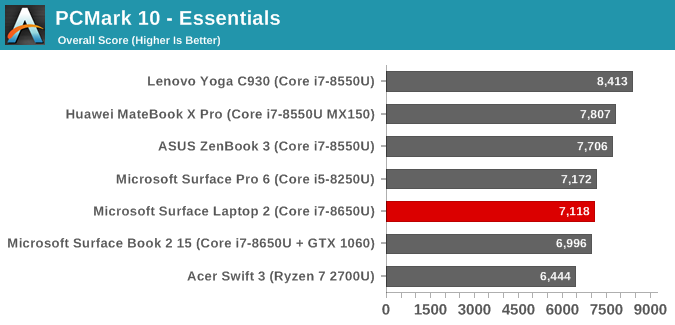
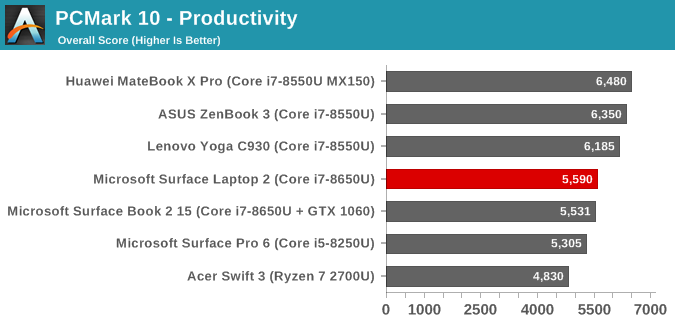
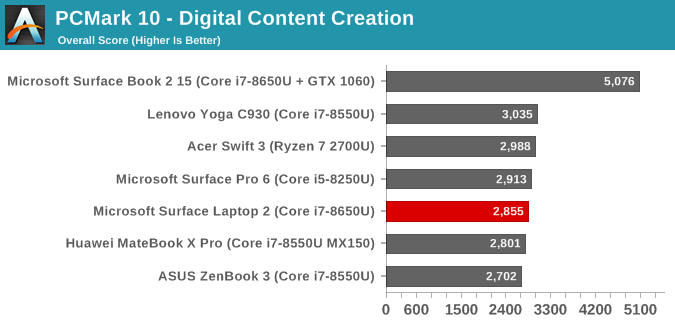
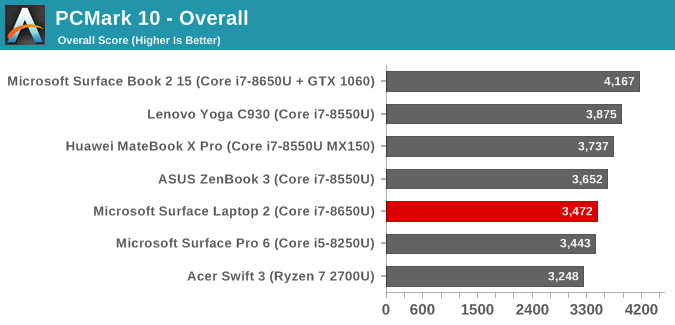
PCMark tests all aspects of a system’s performance level, from graphics to storage. The Surface Laptop 2 is mid-pack with the Core i7-8650U inside. The integrated GPU holds it back in the digital content creation score a bit, but overall it does about what you’d expect from an Ultrabook.
Cinebench
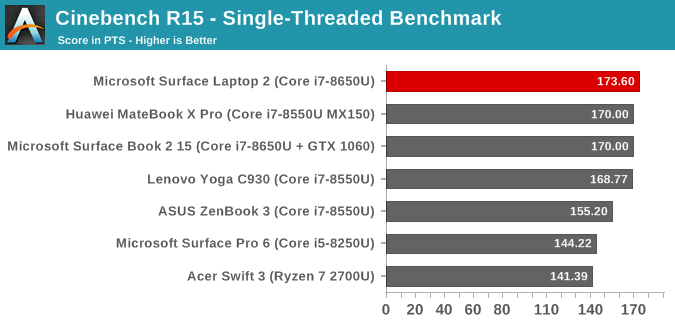
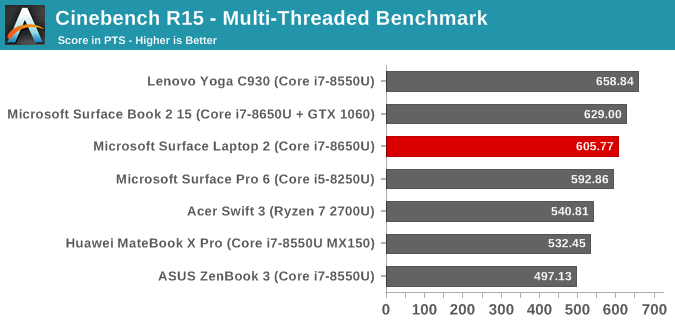
We’ve just got word that Maxon has updated this tried and true benchmark to R20 so we’ll be slowly moving to that updated version in the near future, but since we have back-data from the previous version that’s what we’re using today. The Core i7-8650U tops out at 4.2 GHz which helps a lot in the single-threaded result, and the Surface Laptop 2 holds its own in the multi-threaded test as well, although the Lenovo Yoga C930 is well ahead thanks to Lenovo offering a higher PL2 than we’ve seen on any other laptop.
x264
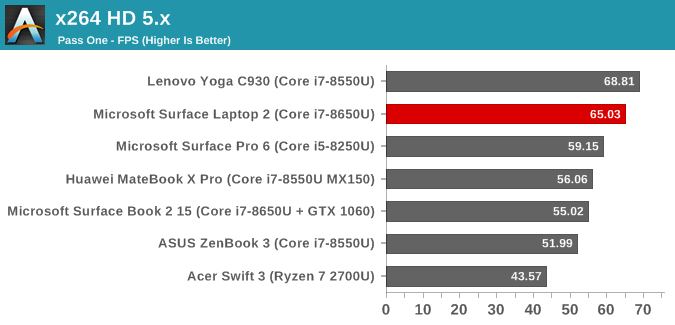
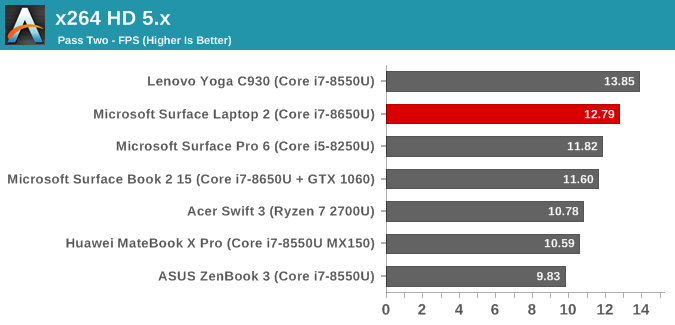
The x264 test is a very long benchmark running four times in a row and can easily take an hour to complete. As such it’s a great test to see CPU performance on a heavy load which will max out the cooling. Microsoft’s Surface Laptop 2 performs quite well here.
Web Results
Browser performance is a major factor in any web-based scripting, and we can see performance scores on the same device change dramatically over time as browsers are updated. Usually the performance trend is upwards, but not always. We standardize on Microsoft Edge for browsing tests.
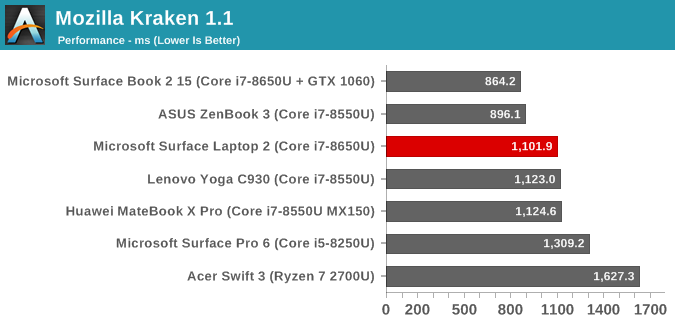

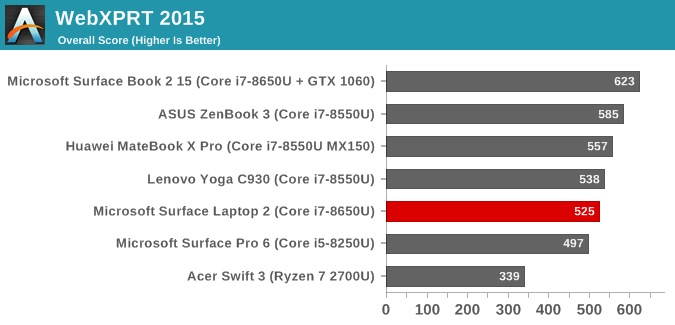
This is one area where Intel tends to hold a lead over AMD thanks to Intel’s work on Speed Shift, which lets the CPU ramp up to maximum much quicker, and that’s important in web results because web workloads are so short. The Surface Laptop 2 with its Core i7 is more or less in-line with the rest of the Core i7 models, where you’d expect it to be.
CPU Conclusion
The Surface Laptop 2 will offer significantly more performance than the original, thanks to the move to quad-core Kaby Lake Refresh. As you can see from the above results though, there’s not a lot of performance difference between the devices which tend to share a common platform underneath. Manufactures just need to make sure they offer enough cooling, and the Core i7 does the rest.











59 Comments
View All Comments
Manch - Monday, April 1, 2019 - link
True no need to fanasize. Just look at Anands bench. Intel has 2 8 series 6C/8T. One cost 100$ more and has a 100mhz base clock bump over the 2k series Zen. Boost clock is also higher. They trade blows but the 2k series zen wins more than it loses. Then look at the 8086 which is double the price and for double the price it beats the 2k series Zen. Fair enough. Looking at the benchmarks, the key gake away is as I said earlier, Intel has the speed still and its enoigh to offset the efficiency gains of Zen's SMT. Unless Intel is holding back soemthing good, the 3rd series Zen will take the Rchitecture from trading blows and winning some to handing out L's.eddman - Thursday, March 28, 2019 - link
What do you mean by "effective"?mr_tawan - Thursday, March 28, 2019 - link
In the other hand, if I wait for half a year and found that the CPU I bought is not much better comparing to the ones available 6 months before, I'd be very disappointed.That is something happened to me before.
That said, I don't think this will be the case for Ice Lake CPUs.
tipoo - Thursday, March 28, 2019 - link
Hopefully that's what they were waiting on for a redesign with USB C/TB3maus92 - Thursday, March 28, 2019 - link
I replaced a MacBook with this machine. The MacOS was having issues with backups and reliable / persistent internal network connections, so this purchase is an experiment. So far, so good. My only complaint is the trackpad - the one on the MacBook was far superior.Eletriarnation - Thursday, March 28, 2019 - link
A bit of a nitpick, but I think this statement in the first page isn't 100% correct:"...16 GB, which happens to be the maximum supported by Intel’s current U-series processors."
This limitation probably only applies to DDR3, as ark.intel.com advertises a maximum of 32GB and DDR4 support for these models too.
Ryan Smith - Thursday, March 28, 2019 - link
To be clear, that passage is solely talking about LPDDR3. Which is why it's mentioned as such in the full sentence."models ship with a minimum of 8 GB of LPDDR3, with high-end and upgraded models increasing that to 16 GB, which happens to be the maximum supported by Intel’s current U-series processors."
Gunbuster - Thursday, March 28, 2019 - link
FIFY: "The Surface Laptop 2 is built out of glue"Should mention nothing is serviceable so you better buy the extended and accidental damage warranty and plan on that "accident" when the battery degrades to 60% in true surface style.
Irata - Thursday, March 28, 2019 - link
Small correction:The article says "Model Tested: Core i7-8650U 8GB 256GB $1299", however further down under pricing, you see:
"256 GB Intel Core i7 with 8GB of RAM: $1599"
Ryan Smith - Thursday, March 28, 2019 - link
D'oh. Fixed. Thanks!